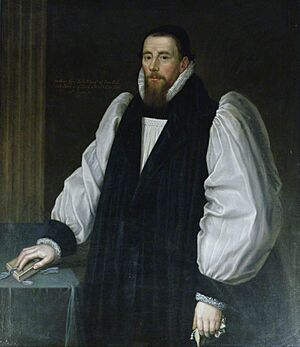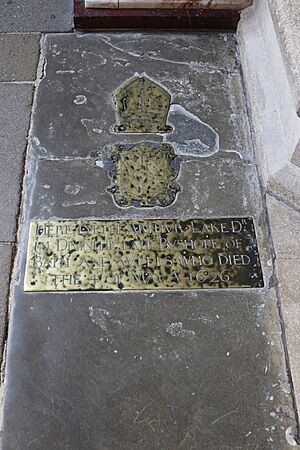Arthur Lake (bishop) facts for kids
Quick facts for kids The Right Reverend Arthur Lake |
|
|---|---|
| Bishop of Bath and Wells | |

Courtesy of the Warden and Scholars of New College, Oxford
|
|
| Diocese | Diocese of Bath and Wells |
| In Office | 1616–1626 |
| Predecessor | James Montague |
| Successor | William Laud |
| Other posts | Dean of Worcester (1608–1616) |
| Personal details | |
| Born | September 1569 Southampton |
| Died | 4 May 1626 (aged 56) Wells |
| Buried | Wells Cathedral |
| Nationality | British |
| Denomination | Anglican |
| Alma mater | New College, Oxford |


Arthur Lake was an important person in England who lived a long time ago (from 1569 to 1626). He was a Bishop (a high-ranking church leader) in a place called Bath and Wells. He also helped translate the famous King James Bible.
Arthur Lake was born in Southampton in 1569. His father, Almeric Lake, worked for the government. Arthur went to King Edward VI School, Southampton until he was 12. Then, he earned a special scholarship to attend Winchester College, a famous school. When he was 18, he went to New College, Oxford, a well-known university. There, he studied hard and earned his first degree in 1591 and a master's degree in 1595. After university, he became a rector (a type of priest) in several towns like Havant, Hampshire and Hambledon, Hampshire.
Arthur Lake earned a special degree called a Doctor of Divinity from Oxford. In 1609, he might have been one of the people who helped edit the new English translation of the Bible. This Bible was ordered by King James I. Arthur's brother, Sir Thomas Lake, worked as a secretary for the King. While there is no clear proof, the initials "AL" appear in the notes for the Bible's review committee.
Becoming a Church Leader
In 1608, a church leader named John Still passed away. James Montague, who was the Dean of Worcester, took his place as the Bishop of Bath and Wells. Soon after, another church leader, Richard Neile, asked Arthur Lake's brother, Sir Thomas Lake, if Arthur would like to become the Dean of Worcester. Arthur Lake chose this important role.
He was officially appointed by the King on April 18 and started his new job on April 23. As Dean, he helped the church leaders buy back some land that had been wrongly leased. He also helped set up a large organ in the Worcester Cathedral and started the cathedral's library.
In 1616, Arthur Lake became the Bishop of Bath and Wells. The King approved his election on October 18. He was officially confirmed as Bishop on December 6 and started his duties two days later. His special ceremony was held on January 3, 1617. The King also made him the Keeper of the Great Seal, a very important government job. He was also knighted in August of that year.
Arthur Lake continued to hold other important positions. He was the head of New College, Oxford and a vice-chancellor (a high-ranking official) at Oxford University until 1618. He also continued to serve as a priest in Stanton St John until he passed away.
Many people admired Arthur Lake. A writer named Thomas Fuller said that Arthur was promoted not just because of his powerful brother, but because he truly deserved it. He was seen as a role model for all church leaders. Another person, Richard Smith, was very impressed by Arthur's kindness, modesty, and how he didn't care much for money. Smith called him one of the "greatest helpers of our times."
Later Life and Legacy
Arthur Lake spent his last eight years working quietly at Wells Cathedral. A writer named Izaak Walton said that Arthur made his important church role "the chief care and whole business of life." He often gave sermons (speeches) in the cathedral and nearby churches. He worked hard to make sure that preaching was good throughout his area. Unlike many bishops, he personally checked candidates who wanted to become priests.
Arthur Lake passed away on May 4, 1626. His tomb (a special grave) can still be seen in Wells Cathedral. He had a collection of 300 books, which became the start of the cathedral's library.
Images for kids
-
A contemporary engraving of Arthur Lake by Wenceslas Hollar.
-
Tomb in Wells Cathedral




